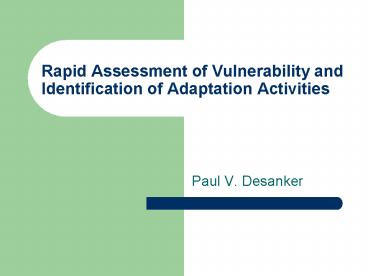Rapid Assessment of Vulnerability and Identification of Adaptation Activities - PowerPoint PPT Presentation
1 / 26
Title:
Rapid Assessment of Vulnerability and Identification of Adaptation Activities
Description:
Maps, tables, etc showing vulnerability. Overlays of threats and population/other ... Lots of information available for free assembled by major users such as ... – PowerPoint PPT presentation
Number of Views:58
Avg rating:3.0/5.0
Title: Rapid Assessment of Vulnerability and Identification of Adaptation Activities
1
Rapid Assessment of Vulnerability and
Identification of Adaptation Activities
- Paul V. Desanker
2
Key Questions for Rapid Assessment
- 1. What is the spatial character of the country
in terms of social, economic and environment? - 2. How will climate hazards likely evolve under
climate change guided by general conclusions from
the IPCC about future extremes? - 2. What are vulnerable sectors, regions and
communities? - 3. What are community options to enhance adaptive
capacity, increase resilience, increase coping
ability? - 4.How can information be packaged and used to
explore NAPA activities in public consultations?
3
Main Steps
- Characterization trend analysis
- Trends in extremes
- Trends in climatic indices
- Spatial characterization using GIS and remote
sensing - Thresholds and pivotal points (turning points)
- Impacts of past policies
- basic human needs in the 1970s
- structural adjustment in the 1980s
- privatization and institution building in the
1990s - poverty reduction in the 2000s
- next ?????
4
Main Steps
- Assessment of Climate Hazards and Risks
- Analysis of historical trends and
characterization of potential future hazards and
risks - IPCC/WMO has standard software and methodologies
- Assessment of Vulnerability
- At appropriate scales of intervention (household,
district etc) - Overlays of exposure, population, etc in GIS,
outputs to include potential affected population
and some idea of cost? - Useful examples include
- World Food Program methods for analyzing food
security using mapping analysis - Famine Early Warning Systems (FEWS) for food
security - use of GIS to evaluate sea-level-rise and
flooding, etc
5
Main Steps
- What is national planning strategy and methods?
- Talk to your planners
- Elaboration of coping strategies and other
intervention measures - Talk with stakeholders
6
Main Inputs .
- GIS data (see CD-ROM from NAPA Primer)
- Admin boundaries, land cover maps, watershed maps
and water bodies, infrastructure, etc - Climate data
- Daily climate data from weather stations
- Gridded data from CRU/IPCC DDC
- Summaries and assessments from past studies
(trends, etc) - Socio-economic data
- Population by management unit (TA), economic
data, indices of socio-economic status
(education, poverty, income, etc) - Background documents and assessments
7
Few Examples of GIS products
- These use existing data from public databases
available in most LDCs - Uses software and techniques used in most
countries - Can be done over days and weeks or hours if
needed, by trained GIS personnel
8
Feb 2000
9
Potential Sources of Flooding
10
(No Transcript)
11
(2001)
Look here Lower Zambezi
12
(No Transcript)
13
(No Transcript)
14
(No Transcript)
15
(No Transcript)
16
(No Transcript)
17
What are data sources?
18
IPCC Data Distribution Center Web data tool
showing temperature variation for January over 95
years
Source http//ipcc-ddc.cru.uea.ac.uk/cru_data/vis
ualisation/visual_index.html
19
Can show January to December temperature (also
rain etc)
Box over Gambia
20
IPCC Web sites for all reports online (see NAPA
CD Tool later)
http//www.ipcc.ch Basis for your science, Also
use local studies
21
Remote Sensing Data Available from Landsat (for
1990, 2000 coming, Showing Land Surface at 30
meters, available for download!) Useful for
visual displays and mapping
Source http//zulu.ssc.nasa.gov/mrsid/
22
Example of product over Zimbabwe/Lower
Malawi/Mozambique Next showing the Shire River,
Lake Kariba, Lower Zambezi River
23
(No Transcript)
24
NAPA CD Tool Contents
- Copies available for LDCs
- Includes GIS data, remote sensing data, documents
and several websites - See handout with contents list!
- Can arrange a display for those interested
25
Main Outputs of Rapid Assessment
- Maps, tables, etc showing vulnerability
- Overlays of threats and population/other
infrastructure - Major threats and potential impacts
- E.g. flood plains, etc
- Suggestions on ho to cope and build resilience
- List of potential actions for key areas
identified from multistakeholder consultation
26
Concluding Remarks
- GIS and remote sensing are powerful tools for
visual display and quick spatial analysis (also
for more complicated models - Allows for new tasks such as address issues of
land tenure, land ownership at a grand scale to
empower the poor - Lots of information available for free assembled
by major users such as government, researchers
and NGOs































